Have you heard of Meursault in Burgundy? Although we certainly had before, we couldn’t have anticipated what it would really look or feel like to spend a week there. Well, recently in June, we set foot in this charming little town for the very first time. And it proved to be an ideal base for exploring Beaune and the surrounding Burgundy region, with its vineyards, châteaux and quaint villages. Let’s start the visit!
Meursault in Burgundy: what does it mean to you?

When someone mentions Meursault, what does it mean to you?
If you are American or British, you may have in mind the amazing white wines that have made the little town famous.
But if you are French, there will be something more attached to it.
A movie. And not just any movie. THE movie that was the most successful French film in France for over forty years. It topped the French box office with over 17,275,000 cinema admissions.
“La Grande Vadrouille”
That comedy film dating back to 1966 is “La Grande Vadrouille“, oddly translated in English as “Don’t look now: we’re being shot at”.

Some famous scenes of the movie took place in Meursault… which explains why French tourists may not (only) come for good wine but to see for themselves the iconic landmarks featured in the legendary movie.
But let’s stick with the English reader who may not be familiar with actors Louis de Funès and Bourvil. And explore Meursault and its neighbourhood.
Last June we were fortunate to make it our base to discover this lovely part of Burgundy.
It was just divine… so many things to see: medieval castles, wine-grower’s châteaux, impressive wine cellars, elegant town-houses, fresh food markets, museums…
Without forgetting those little daily things that make a stay in Burgundy so enjoyable.
Like strolling home along a quiet village street from the boulangerie with the freshly baked bread of the morning tucked under your arm!
You know, the French vacation we are all dreaming about.
Well, let us tell you about our week in Burgundy, starting with the cottage we stayed in!

Our base in Meursault in Burgundy
Meursault is a good spot to base yourself for a week or two in Burgundy.
Véraison – La Maison, a luxury holiday rental cottage that occupies a former wine workers’ residence from the 1700s era is in a brilliant location. We were fortunate to stay in the owner’s converted barn next door but had a good look around the main house which is beautifully renovated.

The old house has been renovated to offer all the modern comforts of a 21st century home! It has luxury linens and quality furniture and bathrooms. The beds are larger than average with superior quality mattresses that you don’t often find in holiday accommodation.

The cottage includes two levels of indoor living space and a private outdoor courtyard. You can comfortably stay there with 4-6 adults and a couple of young children.
Ideal for families or for small groups…
What makes this holiday home so special is the flexible, separate spaces.
It is therefore ideal for families or for small groups that want to enjoy time together – and separately. With a room that can be either a second salon or an extra third bedroom complete with an attached shower room, everyone can relax in comfort. Each bedroom features a private ensuite bathroom and air-conditioning, a rare find in French wine country. It’s a clever layout and the outdoor space really makes it.











A haven of peace in the heart of Meursault!
From the house, you are only steps away from the village centre yet once you close your doors and enter the courtyard you are in your own haven of peace.



As I said, where we stayed was ideally situated to explore not only the charming wine village of Meursault in Burgundy but also the surroundings.
To find out more about this lovely holiday home and to book your stay visit their website.
What to see in Meursault…
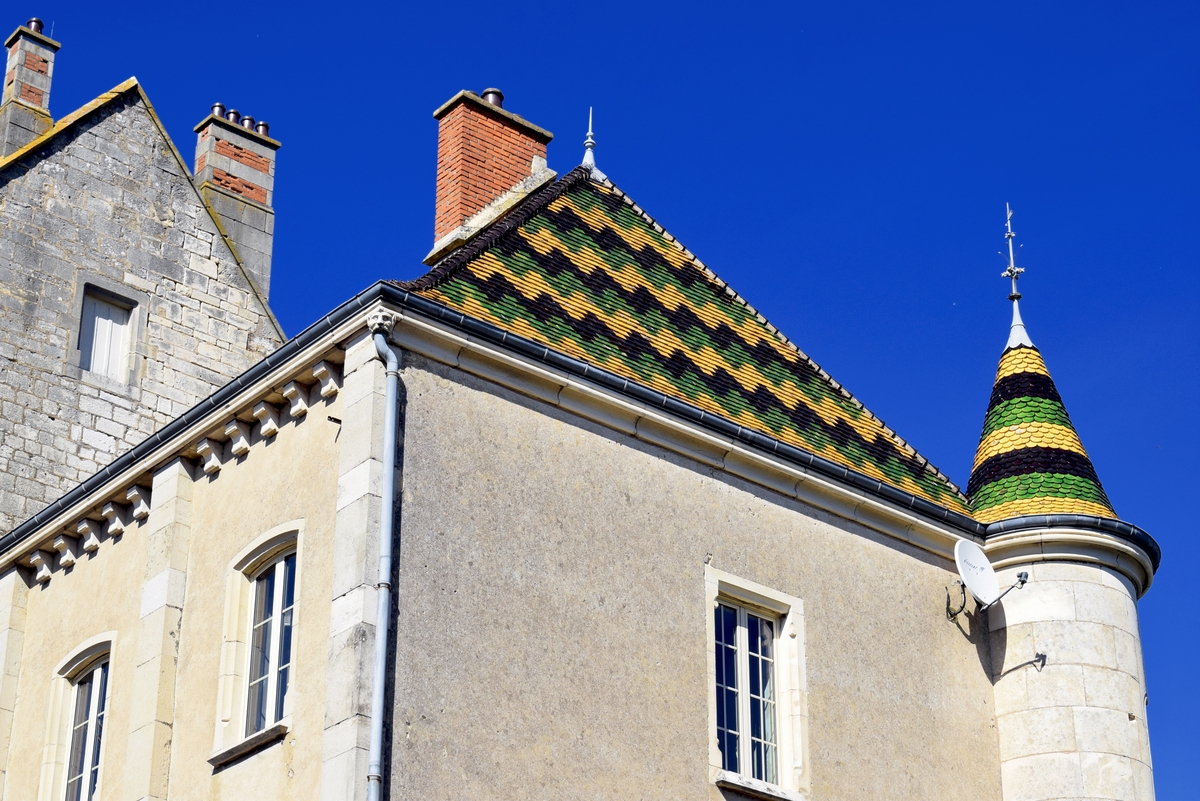
As I was working on this article, my research led me to many websites about the Burgundy village.
Interestingly the vast majority revolved around the great and famous white wine of Meursault!
Setting aside the wine which is in itself a major attraction and merits a whole other article, let’s talk about sightseeing in Meursault.
Although a small town, Meursault has a lot to offer its visitors. And of course, most of that is associated with the local wine!
Our holiday base was located literally one-minute walking distance from the town’s main square and the little shopping precinct.
Practical Meursault!
In Meursault, you will find most of the commodities you’ll need for a one or two-week stay.
There is a good selection of cafés and restaurants, two boulangeries-pâtisseries (bakery-cake shop), a butcher, a newsagent, a bar-tabac, a mini supermarket, a beautician, a florist, a gift shop, a wine shop (of course!), a few hairdressers and a useful visitor centre…



Check out the cottage’s website for more info about local services and places of interest in Meursault.
The Town Hall, former feudal castle of Meursault
The town hall occupies the site of what was once Meursault’s feudal castle. Dating back to 1337, it was restored in the 15th, 18th and 19th centuries to become today’s iconic town hall of Meursault.

Of the medieval castle survive the tall square keep and mullioned windows. The town hall with its glazed-tiled roof featured in a famous scene of the popular French movie I mentioned earlier “La Grande Vadrouille” (1966) starring Louis de Funès, Bourvil and British actor Terry-Thomas.

The edifice is enhanced by a beautiful fountain in a semi-pedestrian area:
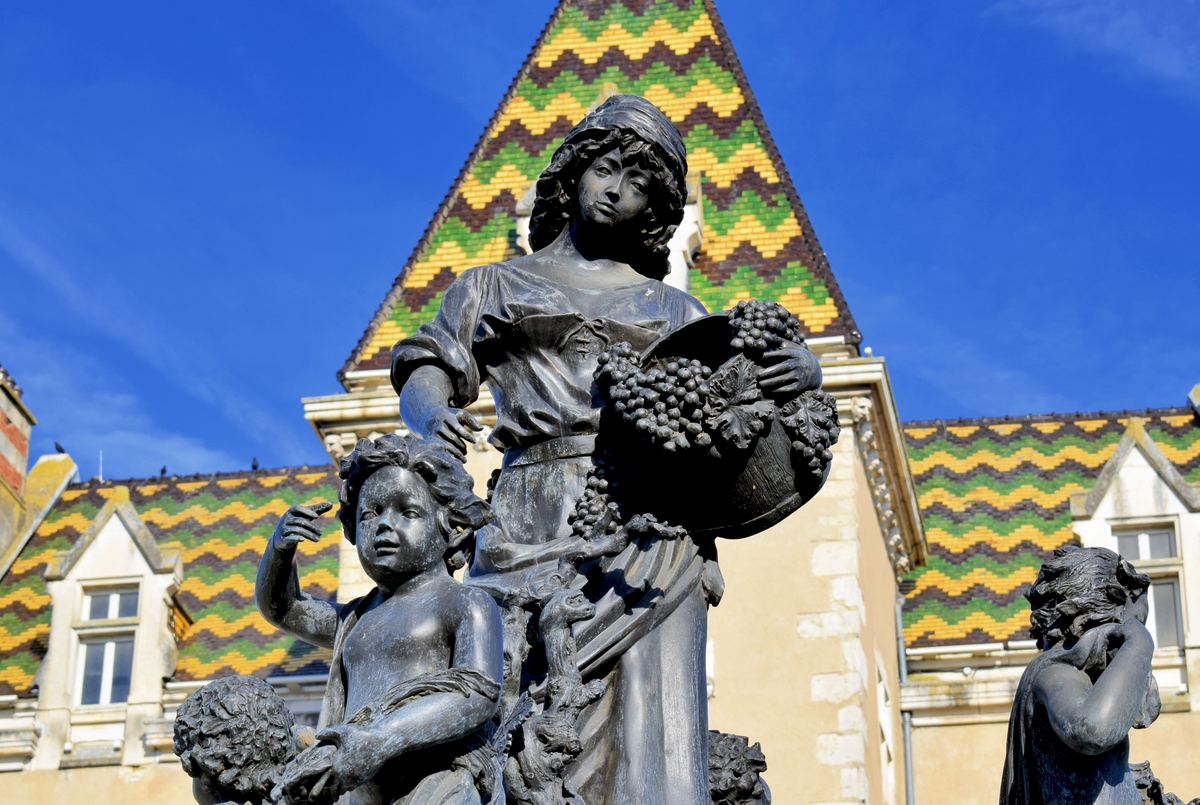


The parish church
Not far from the square is the parish church of Saint-Nicolas. Its 57-metre-tall spire dominates the whole town and its surroundings.

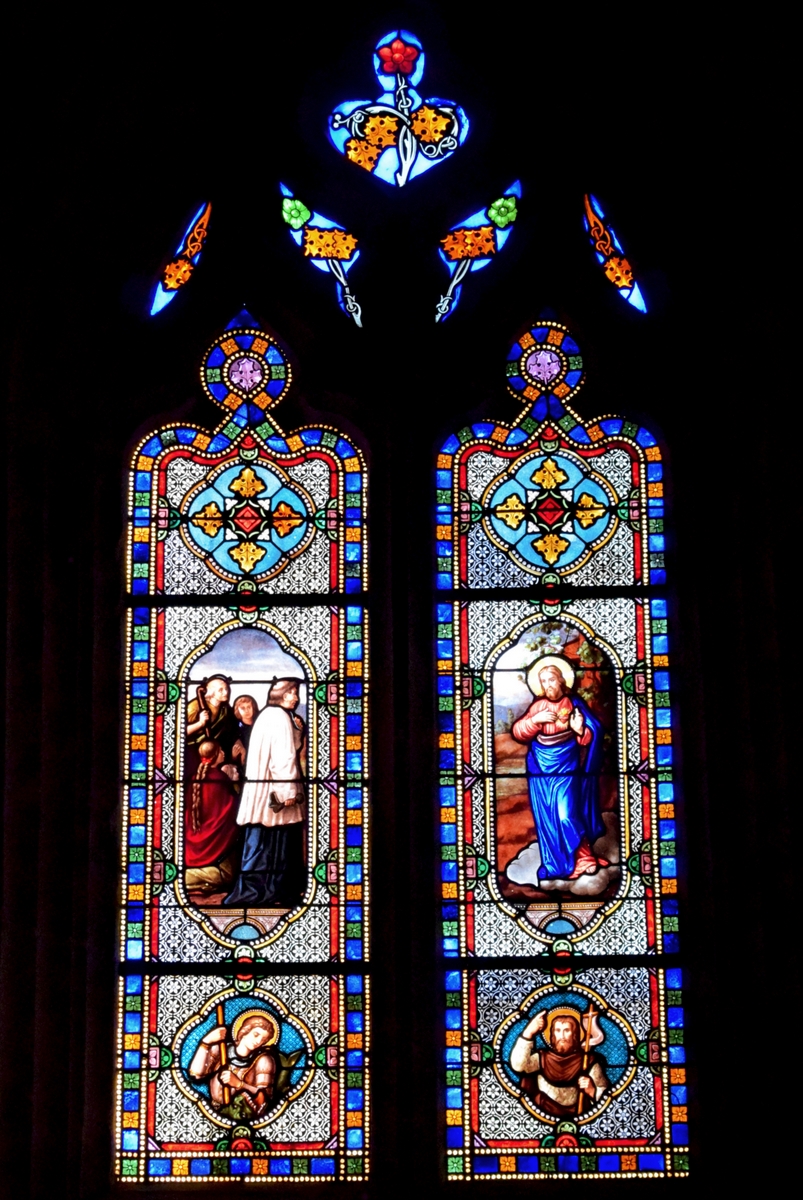
Exploring the old streets
If you’re like me, you’ll love strolling around the old streets of the celebrated wine town of Meursault.

Many stone-built houses testify to the long-standing, wine-inspired prosperity of the town.

We loved taking the time to check out the details of Meursault’s seductive corners: old doorways and ornate lintels, forged iron balconies, patterned roofs, turrets, washhouses, leafy gateways hiding secret gardens…
Some photos shot in the streets of Meursault






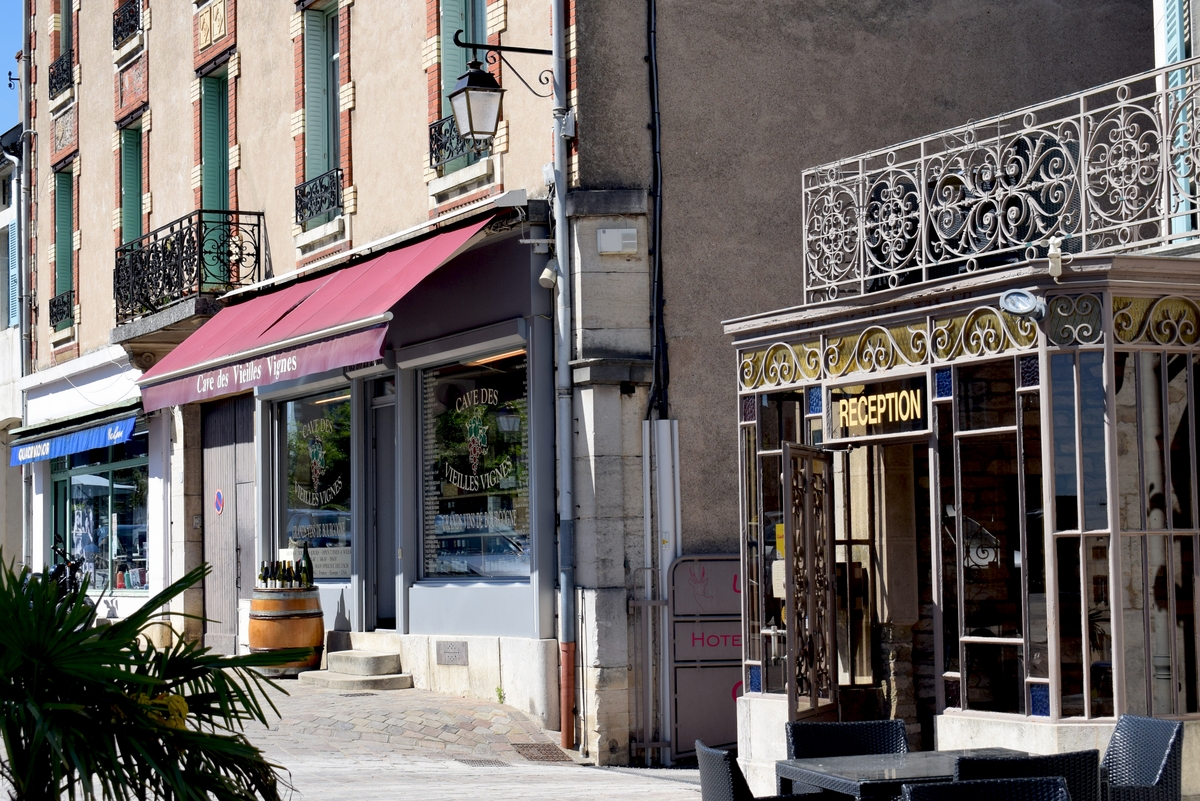






The château de Citeaux
At the centre of the village, this château reveals an elegant French-style façade. Today the edifice houses a four-star hotel and the acclaimed gastronomic restaurant “La Cueillette”.


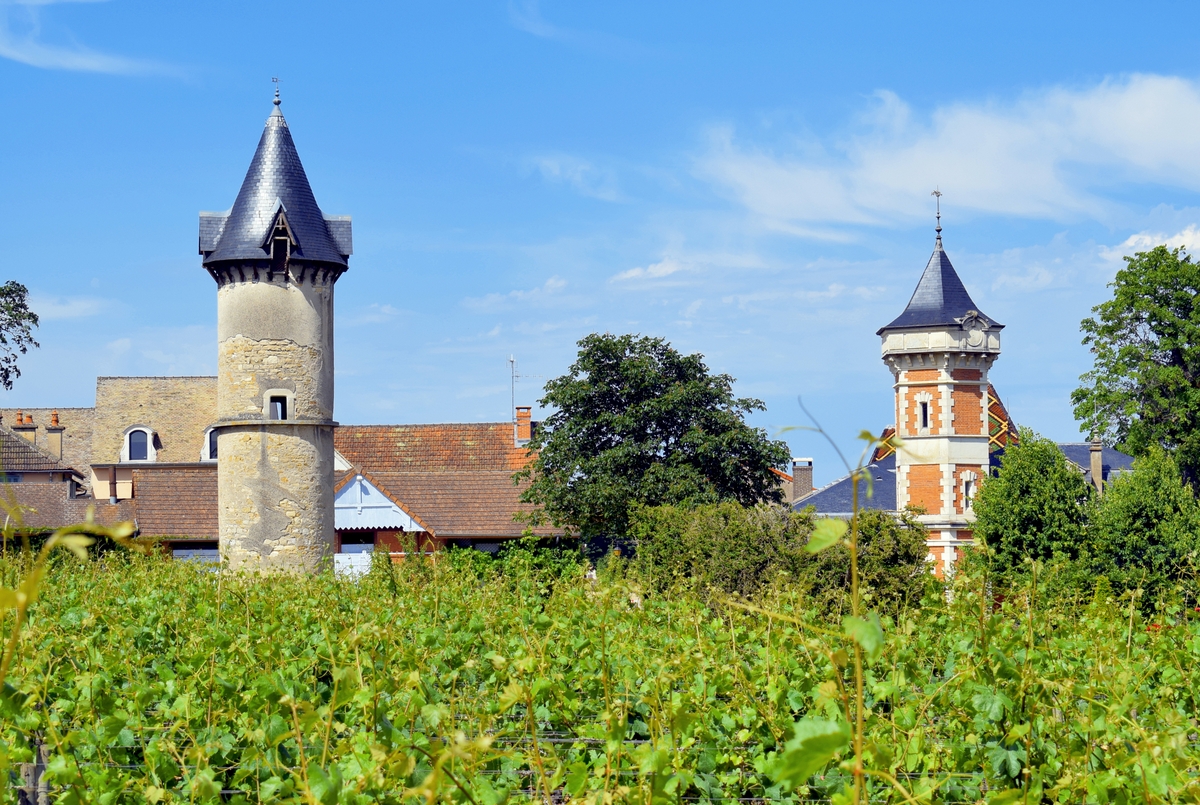

The château de Meursault
The origins of the château de Meursault date back to the 11th century.
The Cistercian-style cellars are from the 12th, 14th and 16th centuries. They give an idea of the unquestionable grandeur of Burgundy wine-making. The splendid cellars contain 800,000 bottles of wine!

The wine-producing estate extends over 65 hectares with chardonnay for white wines and pinot noir for red wines.
The vineyards of Meursault
Meursault’s vineyards seem to cover every available hectare around the village.

Walk uphill across the vineyards to reach the wine growers’ Folies. These pretty villas are scattered among the vines.



If you decide to walk on a sunny afternoon, you’ll enjoy fantastic views of infinite charm to:
- Meursault,
- the vineyards of Burgundy and
- the plain of the Saône,
- in the distance the Jura mountains
- (if the weather conditions are excellent) the mountain tip of Mont-Blanc!
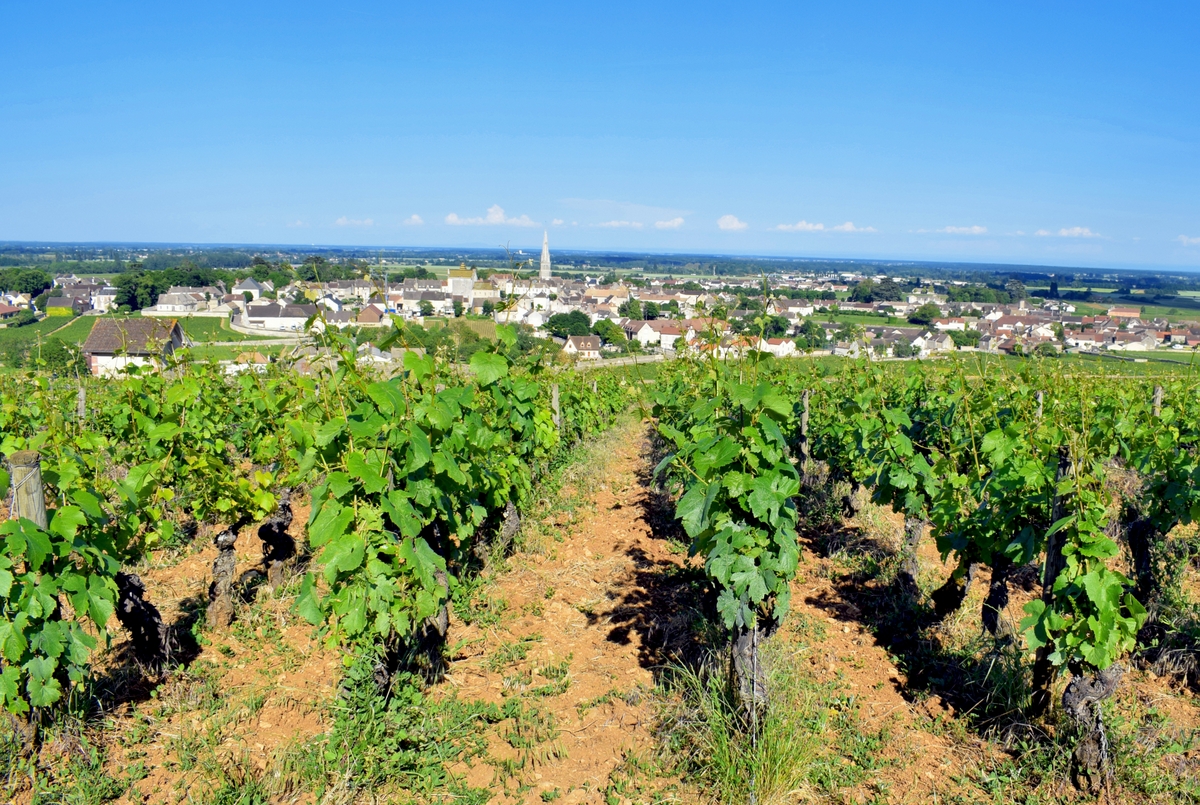



The Côte de Beaune
Meursault makes a good base for touring the Pays Beaunois, the surroundings of Beaune.

The Côte de Beaune is home to names of legendary vineyards: Pommard, Volnay, Santenau, Aloxe-Corton…
The vineyard of the Côte de Beaune stretches from Ladoix-Serrigny to the North to Cheilly-lès-Maranges to the South. This narrow but long territory is home to a number of famous villages made famous for their wine production. They kind of look like small wine principalities in the vast kingdom of Burgundy wines.
The vineyards of the Côte de Beaune are divided into “clos“, a walled vineyard. Every one of these plots has a story to tell. This is what you’ll notice when driving on the narrow lanes across the Côte.

Here are a few places we visited while staying in Meursault:
Santenay, a castle and 400-year-old trees!
11kms from Meursault
The village is nestled in the middle of the vineyards around its medieval castle.

Known as the castle of Philip the Bold (1342-1404), Duke of Burgundy, the fortress was built in the 14th century on the site of a former Roman castrum.

We recommend visiting the castle’s cellars on a tour.

You’ll get to see the stunning vaulted cellars from the 9th century. On the guided tour you’ll learn more about the wines of Burgundy ‘from the terroir to the cellars and from the vine to the glass’. And to end this discovery with style, take part in a tasting of the Domain’s wines!
Book your tours and tastings at the château of Santenay
The castle’s park
Before leaving the glazed-tiled roof castle, have a stroll in the beautiful park.



Notice the two plane trees at the entrance gate. Listed as one of “France’s remarkable trees”, they are 400 years old.

These Platanus orientalis (or old World sycamores) were planted in 1599 by order of Henri IV, King of France… Just imagine: they are older than the French Revolution. Older than the discovery of Australia by Captain Cook. When planted, the provinces of Alsace, Savoie and Nice were not yet French!
The Sorine windmill
To the north of Santenay, on the way to Chassagne-Montrachet, stands the Côte’s only windmill.

Now disused the Sorine windmill (1825-1835) overlooks the vineyards of Santenay.
The three crosses of Mont de Sène
15kms from Meursault
Mont de Sène is situated at the limit with two départements: Côte d’Or [21] and Sâone-et-Loire [71]. It culminates at 521 m and offers spectacular views.
- To the west: the Morvan massif
- To the East: the vineyards of Burgundy, the plain of the Saône, the city of Chalon-sur-Saône, the Jura mountain range and – on a fine day – the Alps.
Photos from the summit:








An ancient Pagan site
This is the site of a Stone Age necropolis. There the Celts worshipped their gods, as did the Romans who built two temples at the summit (one dedicated to Mercury and the other one to the divinity of River Terron whose source is at the mountain). Both were destroyed in the 5th century.
In 1767 a calvary with three crosses was built, hence the mountain’s nickname of “Three Crosses Mountain”.

The market of Chagny
8kms from Meursault
The little town of Chagny lies at the southernmost place of the Pays Beaunois. It is home to a fine Romanesque church from the 11th and 12th centuries.

But it was thanks to a local’s tip that we ended up visiting the market of Chagny on a Sunday morning. The English resident told us that this particular market was much more authentic (and cheaper!) than the more touristy one of Beaune.

The market takes most of the old town’s streets… and as a visitor, it makes it difficult to find the right stall with affordable prices. But after looking around for a while and asking some locals, we found THE vegetable farmers’ stands with delightful produce!
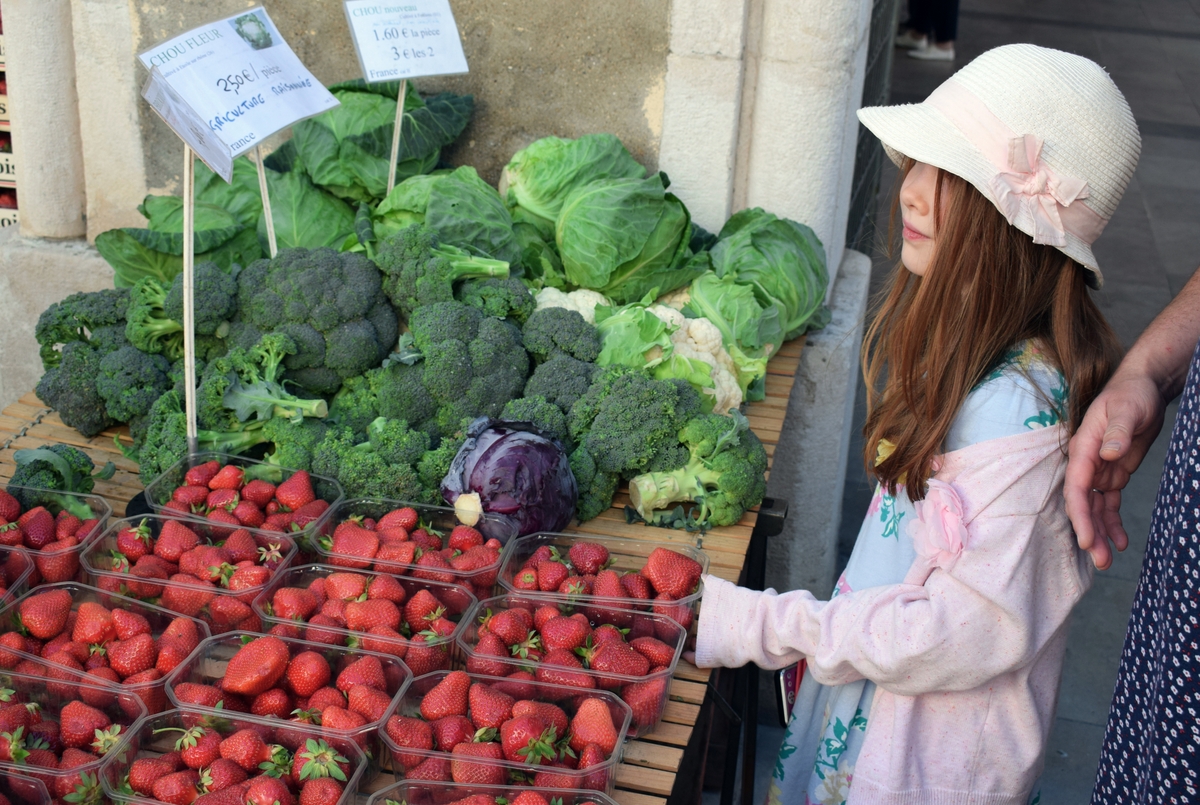

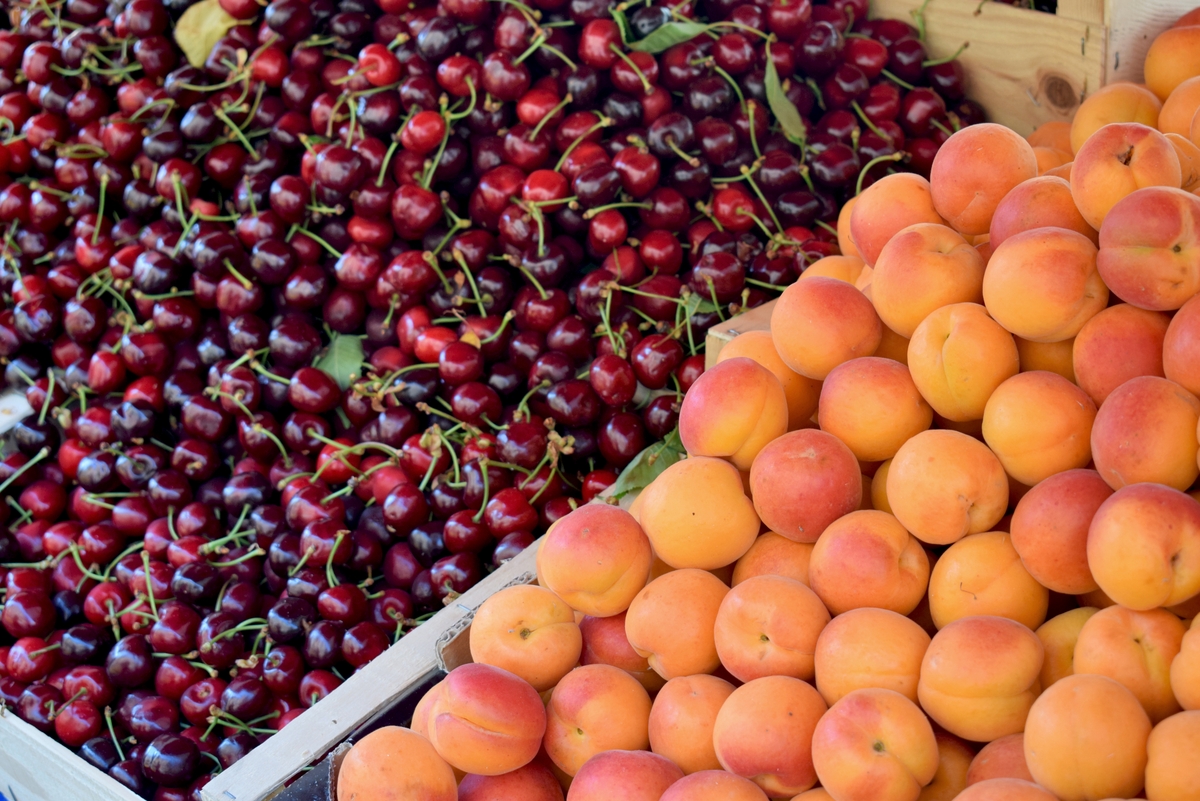

The fairy-tale château of Aloxe-Corton
14kms from Meursault
I had seen it first on a coffee-table book about Burgundy. And I had to see it with my own eyes!
This is the beautiful château of Corton André, located in the village of Aloxe-Corton, north of Beaune.

The roof is ornate with the typical Burgundy glazed tiles.
Just don’t be fooled by its fairytale look. For this château was built in the 19th century on the site of a château from the 18th century.
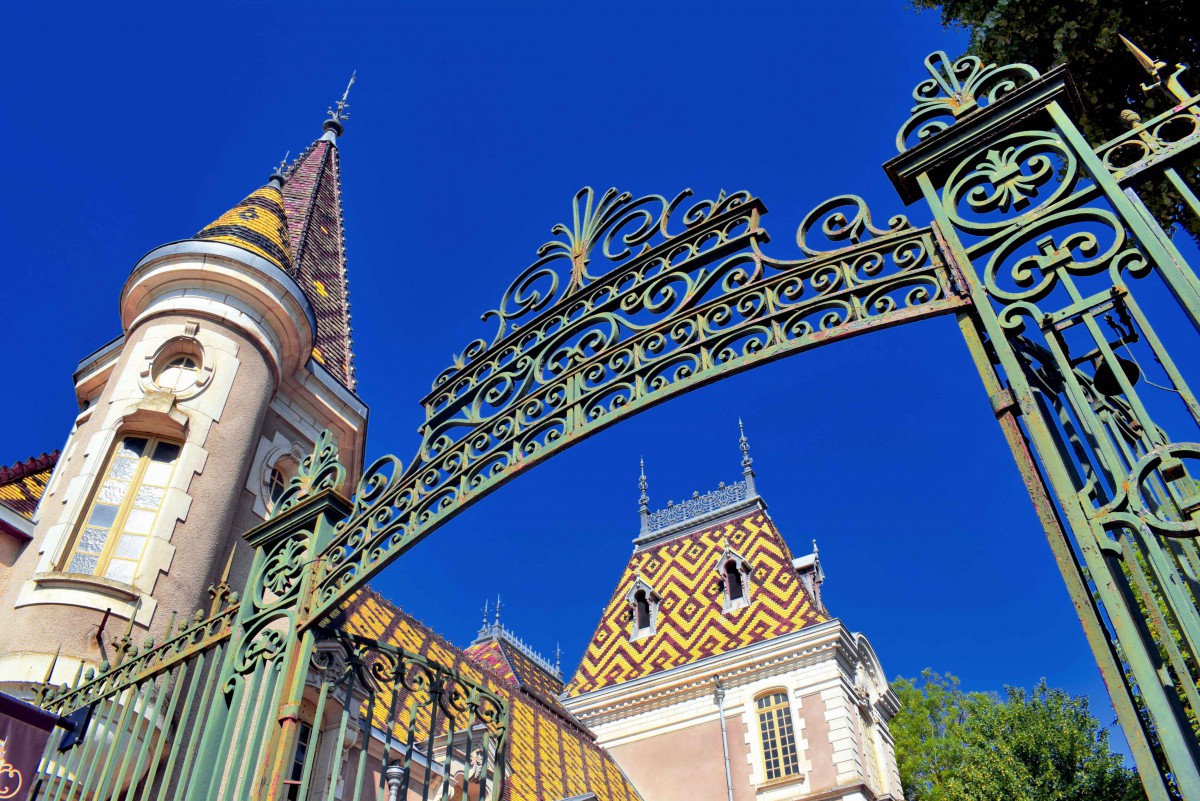
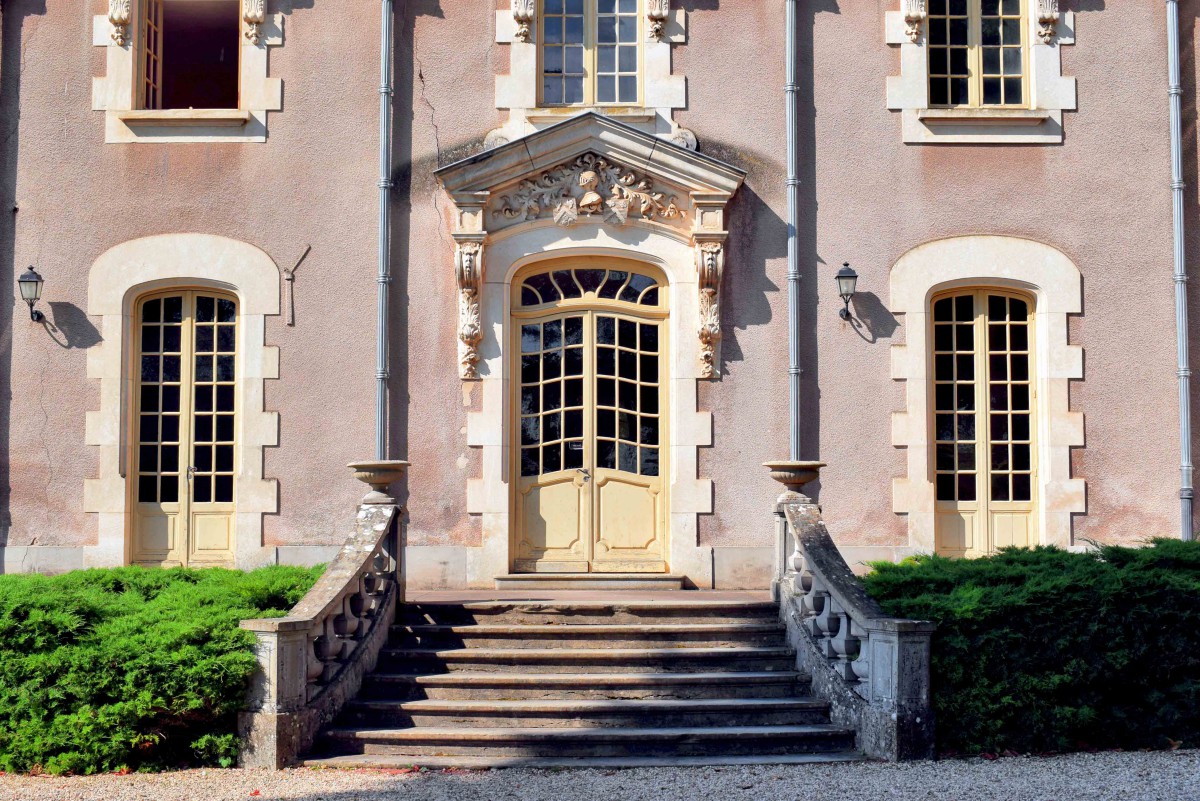
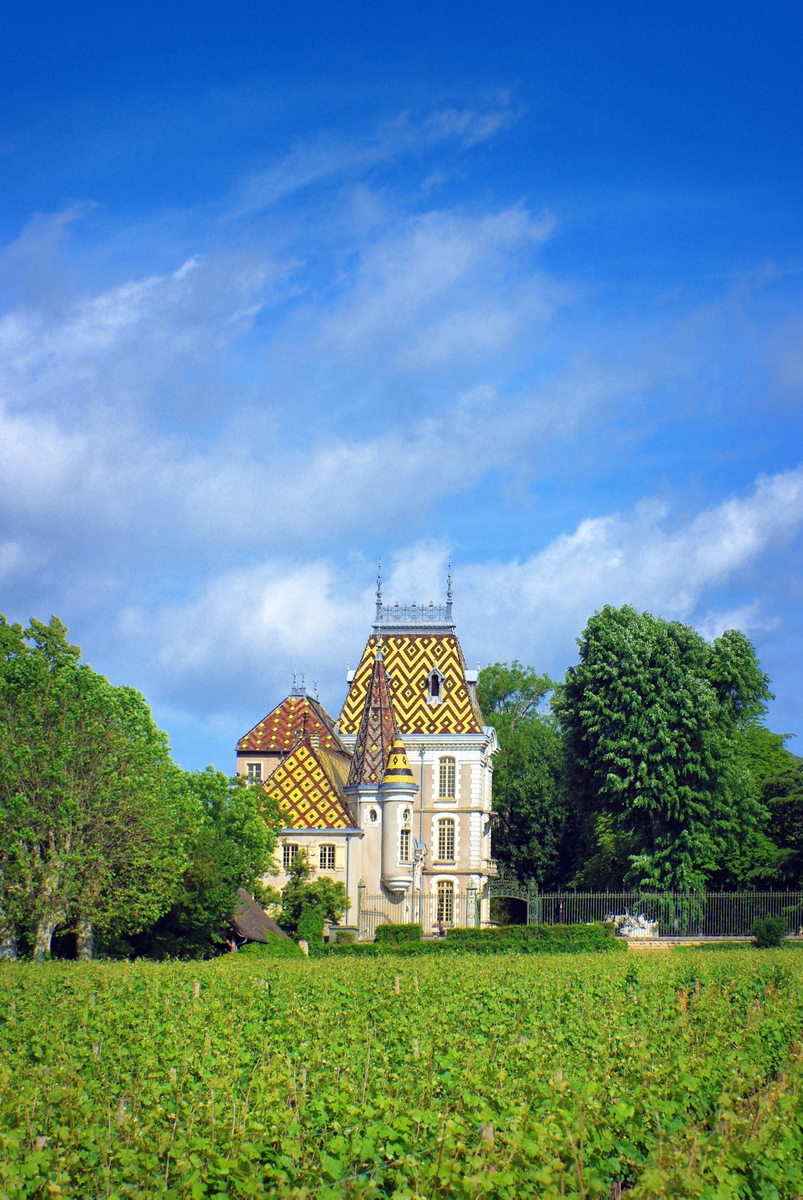
The domain of Maison Pierre André extends across 150 hectares of vineyards shared by the communes of Aloxe-Corton, Ladoix-Serrigny and Pernand-Vergelesses:
- grands crus Corton (red wines)
- grands crus Corton-Charlemagne (white wines).
The old town of Beaune
10kms from Meursault
Beaune is the proud Capital of the Burgundy Wines. It has been so for a long time.
About to be beheaded by his brother, the King of England, George Plantagenet, Duke of Clarence (1449-1478) is said to have declared:
“I should like to be drowned in a vat of Beaune wine so that my death is effortless and good”.
True or not, it only reinforces the historic fame of Beaune. Indeed, the Unesco-listed town boasts many vestiges of its prosperous past. Therefore, centuries of history pass before your eyes. Old houses, churches and ramparts still show today how Beaune was an important centre of art and culture in the Middle Ages.
The streets of Beaune
Walk on the narrow cobbled streets and tranquil squares to discover many old buildings such as the Maison du Colombier, the Belfry, the Hôtel de la Rochepot, and the Maison du Chapitre…
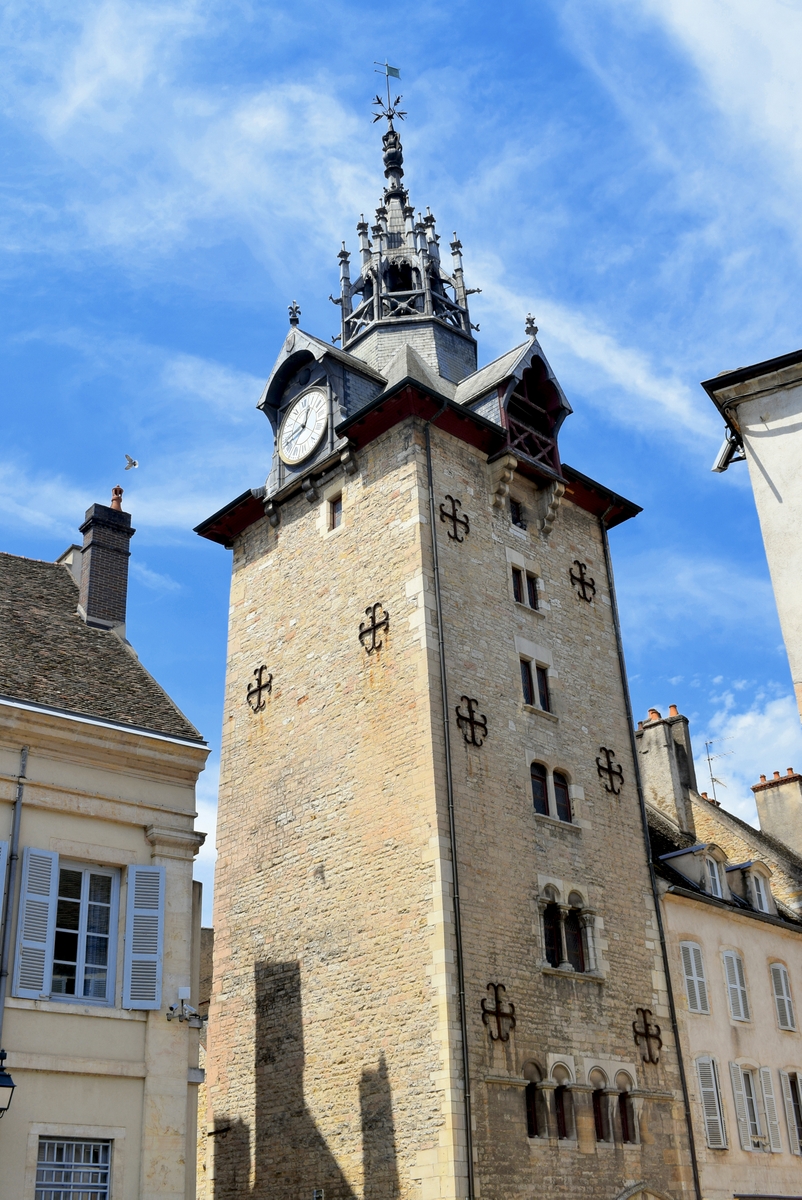




The church of Beaune
The basilica collegiate church of Notre-Dame dates from 1125-1130. It is one of Burgundy’s last great Romanesque churches. Reach the garden to see the remains of the late 13th-century cloister.



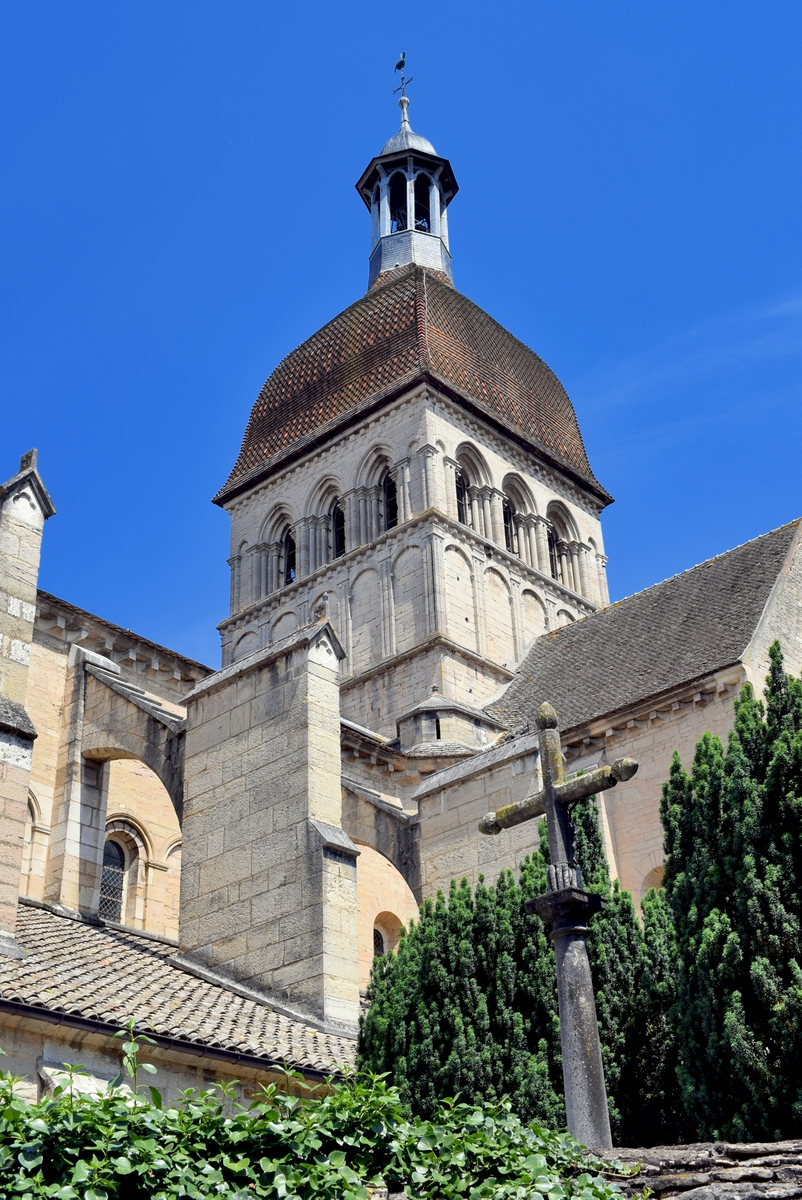
The fortifications walk
The ramparts enclose the tightly clustered old town. A 2.5km promenade leads you along the chemin de ronde with views of the watchtowers and bastions.
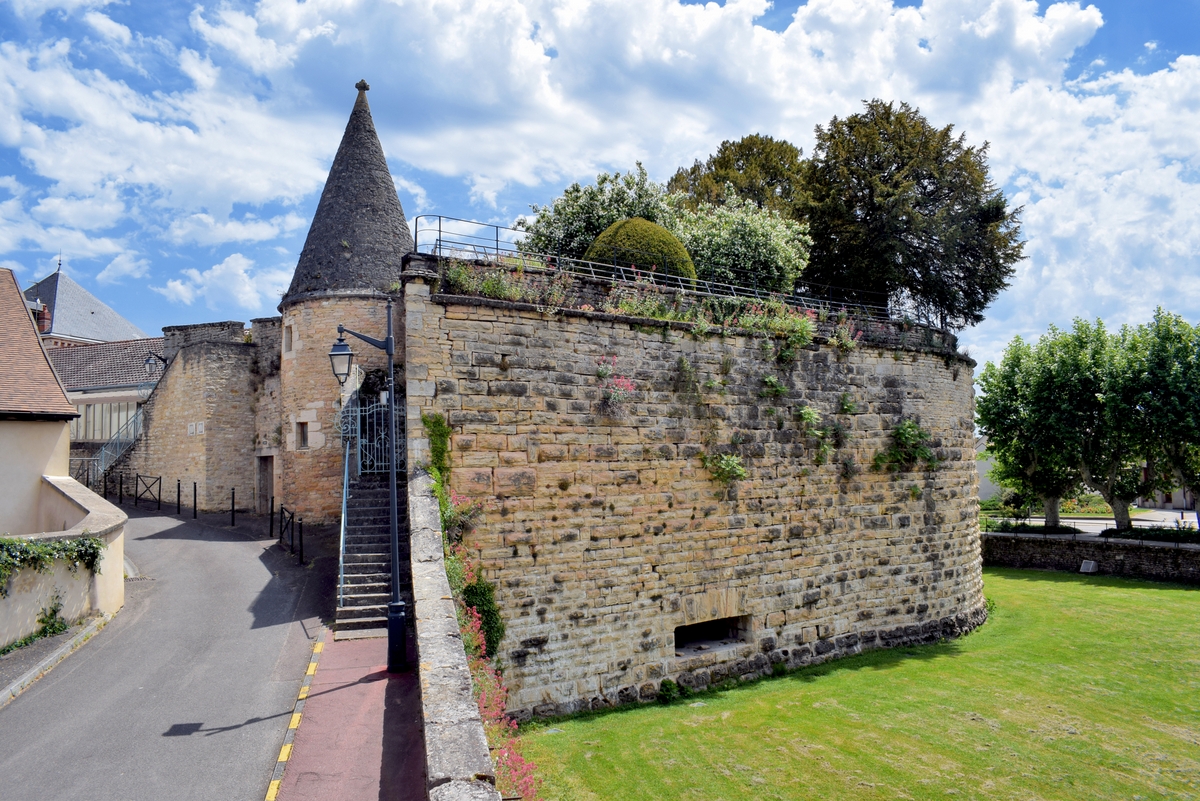
The Hospices de Beaune
The 15th-century hospital known as the Hôtel-Dieu is the chief attraction of Beaune.
Nicolas Rolin, Chancellor of the Duke of Burgundy, founded a hospital for the poor in 1440. Along with his wife, Guigone de Salins, he wished to house the sick, the poor, and the elderly.
Completed in 1457, it was acclaimed as a masterpiece of medieval architecture. It is an emblem of the golden age of the great Duchy of Burgundy.
And at a closer look, you’ll find out that the Chancellor not only built a hospital but a “palace for the poor”!
I was impatient to see the spectacular cobbled courtyard.

The hospice is famous for its massive multicoloured roof. Faithful to the Burgundy tradition, it is patterned with diamonds of flashy glazed tiles – Green, yellow, brown and burnt sienna.
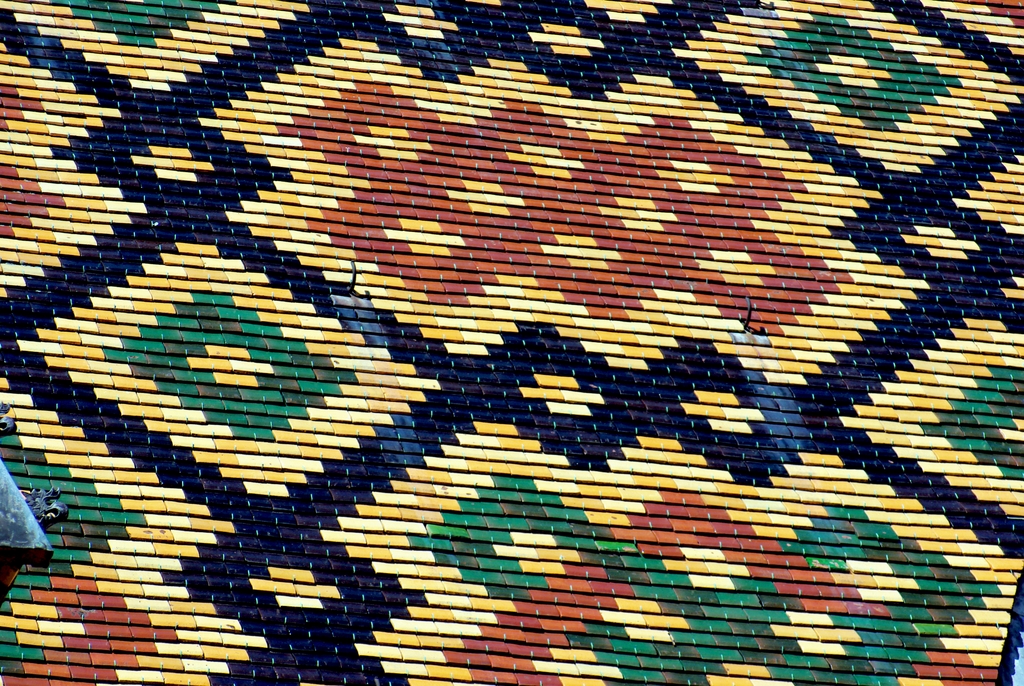
Burgundy’s finest roof!
The magnificent flamboyant Gothic architecture was inspired by the Flemish style. You have to take the time to admire the wooden panelled gallery topped with steep-pitched dormers and turrets. Amazing!









Inside the Hospices de Beaune
Inside, don’t miss the grand “Salle des Pôvres” (Paupers’ Room). The 51-metre-long paved hall features 28 original yet curious wooden beds lined up in two rows. Look up at the painted beams that support the arched timber roof.
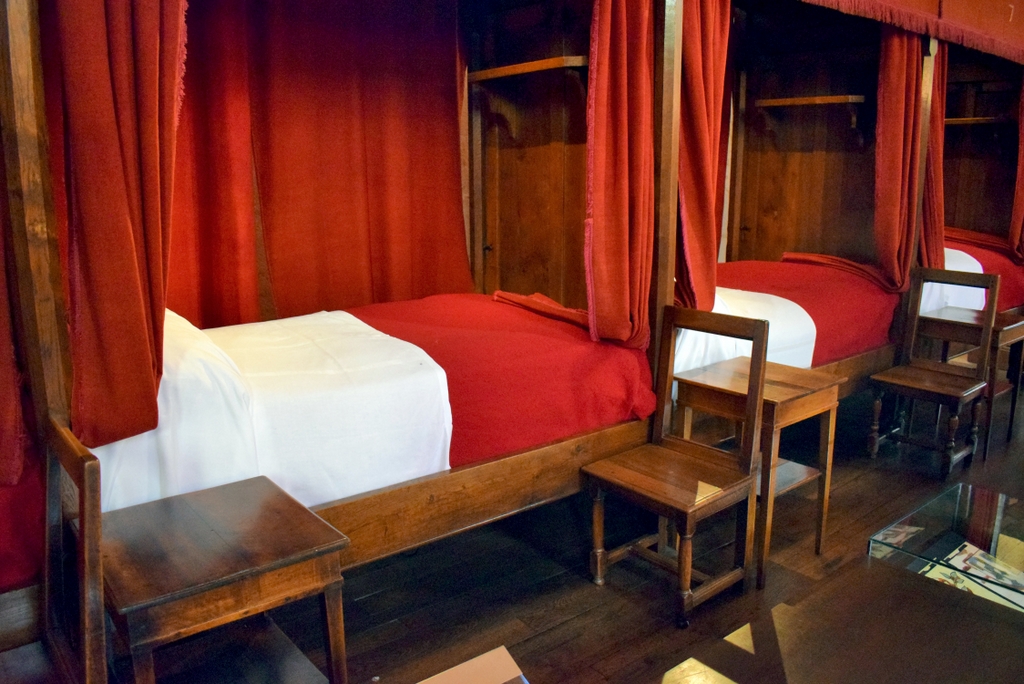
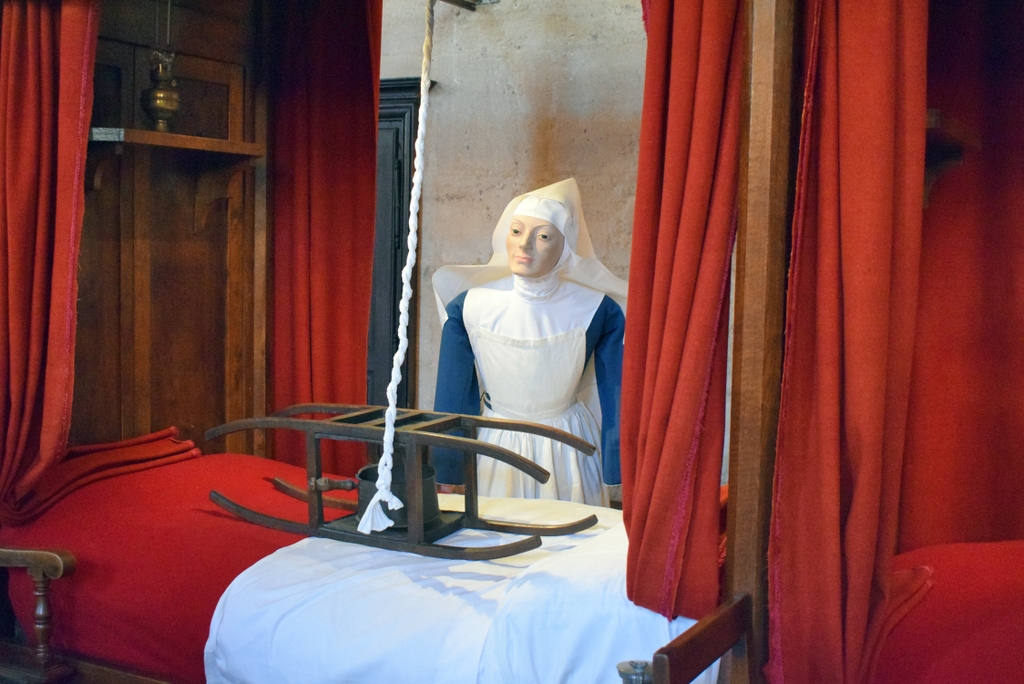

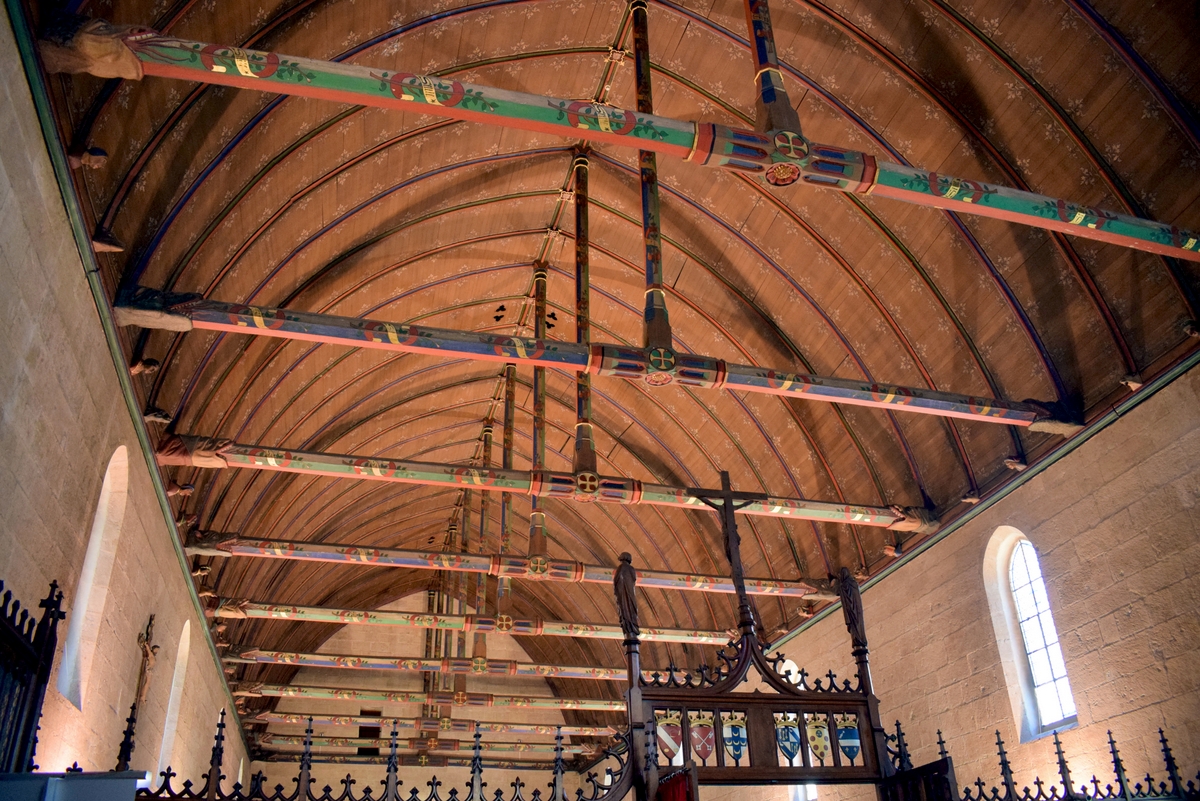
The edifice also houses the wonderful altarpiece of the Last Judgement by Rogier van der Weyden (15th century).

Lastly, the Hôtel-Dieu still manages a wine-producing estate today of more than 60 hectares!
A family-friendly visit
What we loved about this visit is that they had an amazing audio guide, especially for children with their own separate itinerary and numbers to follow which was fun and kept our 6-year-old enraptured for the whole time.

The adult version is, of course, more detailed but it’s easy to all follow round as a family each with their own audio guide to listen to the commentary at each numbered stop.
More info about visiting the Hospices de Beaune
The Côte de Nuits
If you are a wine lover, places in the Côte de Nuits will be like music to your ears: Fixin, Gevrey-Chambertin, Vougeot, Vosne-Romanée, Nuits-Saint-Georges, Chambolle-Musigny… Yes, kind of the “Champs-Elysées of Burgundy”!
Nuits-Saint-Georges
24kms from Meursault
Halfway between Beaune and Dijon, the little town of Nuits-Saint-Georges is the capital of the Côte de Nuits vineyards. The picturesque town’s chief glory is its belfry from the 17th century topped with a fine bell turret.
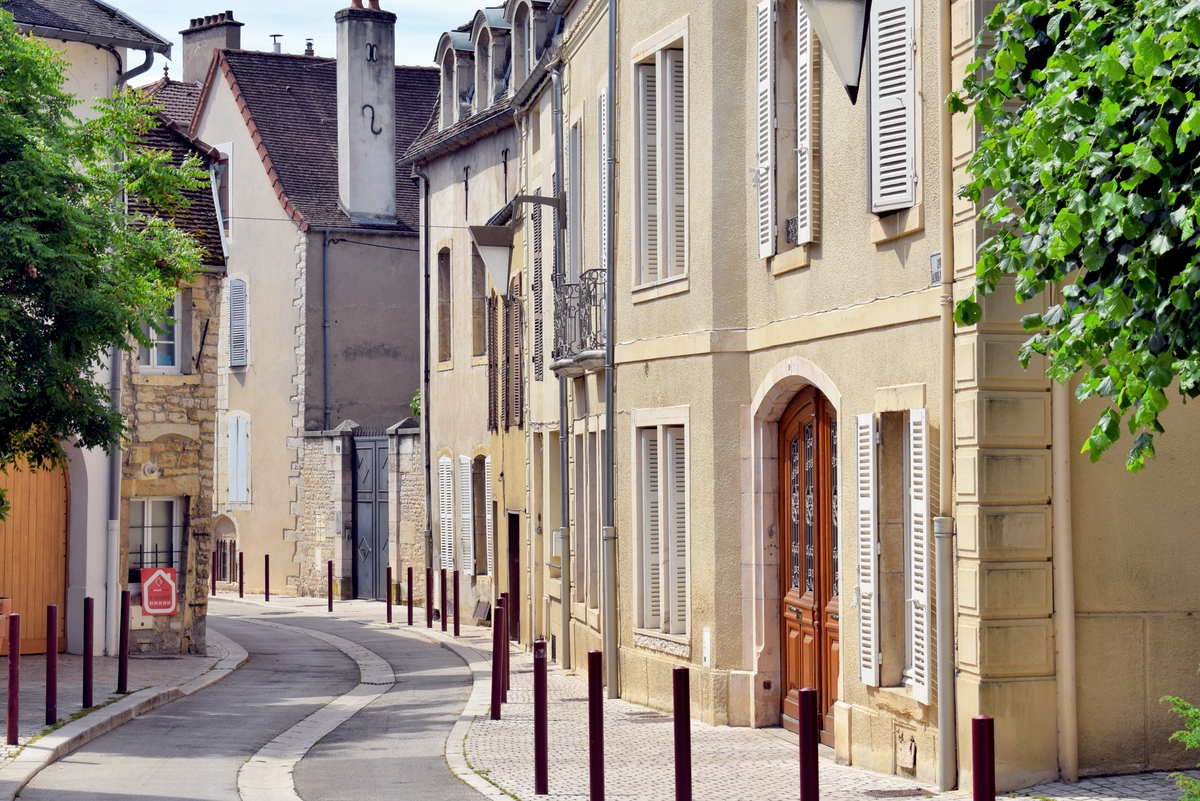


Nuits-Saint-Georges is also noted for the magnificent Romanesque Saint-Symphorien church from the 13th century.



Le Clos de Vougeot
30kms from Meursault
Tightly surrounded by the vineyards, the castle of the Clos de Vougeot is an emblematic spot in Burgundy. It could well be the Acropolis of Burgundy!

Cistercian monks planted the vineyards here around 1100. But the actual building dates from the 16th century. The domain of the Clos de Vougeot extends over 50 hectares of walled vineyards. They produce one of the best red wines in the world.
The château of the Clos de Vougeot is the seat of the “Confrérie des Chevaliers du Tastevin“. The world-famous exclusive brotherhood of Burgundy wine enthusiasts was founded in 1934. Its motto is “Never in vain, always in wine”. Delightful!
The primary aims of the organisation are:
- “To hold in high regard and promote Burgundian produce, particularly her great wines and regional cuisine.
- To maintain and revive the festivities, customs and traditions of Burgundian folklore.
- and to encourage people from all over the world to visit Burgundy.”
On your visit to the Wine museum in the castle, you’ll get to see the impressive cellars and wine presses from the 13th century.
Fixin and Fixey
38kms from Meursault
Sitting in the vicinity of Dijon, the wine village of Fixin (pronounce ‘fissin‘) boasts a fine Romanesque church. Saint-Martin de Fixin dates back to the 12th and 15th centuries.

In the hamlet of Fixey (pronounce ‘fissay‘), part of the commune of Fixin, is another, much older church. Rising above the vineyards, Saint-Antoine de Fixey was built in Romanesque style in the 10th and 12th centuries. Notice the glazed-tiled roof which is more elaborate than that of Fixey. A picture-postcard view of the vineyards of Burgundy.

Dijon: capital of Burgundy
55kms from Meursault
If you stay in Meursault, a day trip to Dijon is compulsory!

The capital of Burgundy is one of the most touristy provincial towns in France and it would be a shame to miss it!
There are so many things to see in Dijon. I am planning to write a dedicated article about our stay over there.
The old town of Dijon
In the meantime, here are a few ideas for a visit:
The old town has a few streets bordered by amazing half-timbered houses. Check out rue Verrerie, rue de la Chouette, place Vauban.




The churches of Dijon
Dijon is home to a few churches worth discovering: the Saint-Bénigme cathedral, Saint-Philibert church, church of Notre-Dame and church of Saint-Michel.



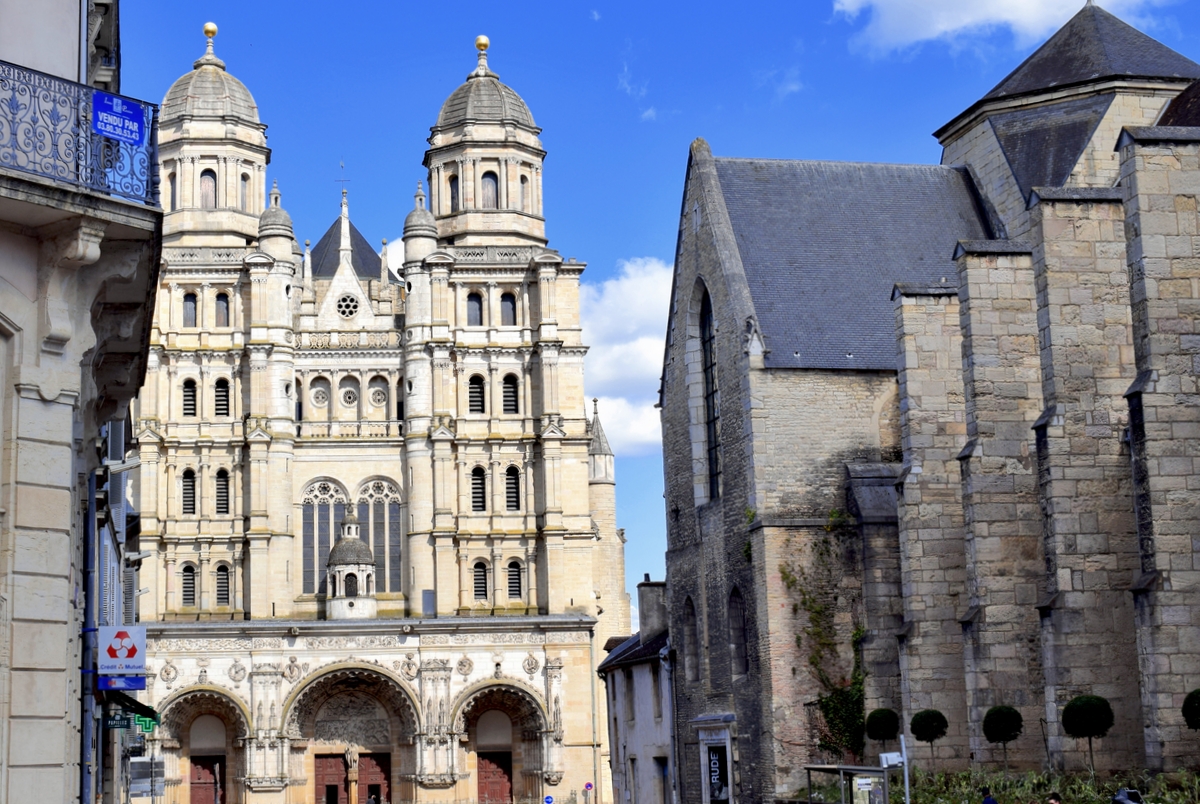


The Ducal Palace
The Ducal Palace and its neo-classical architecture. Inside you’ll find the great Fine Arts Museum which has recently reopened.

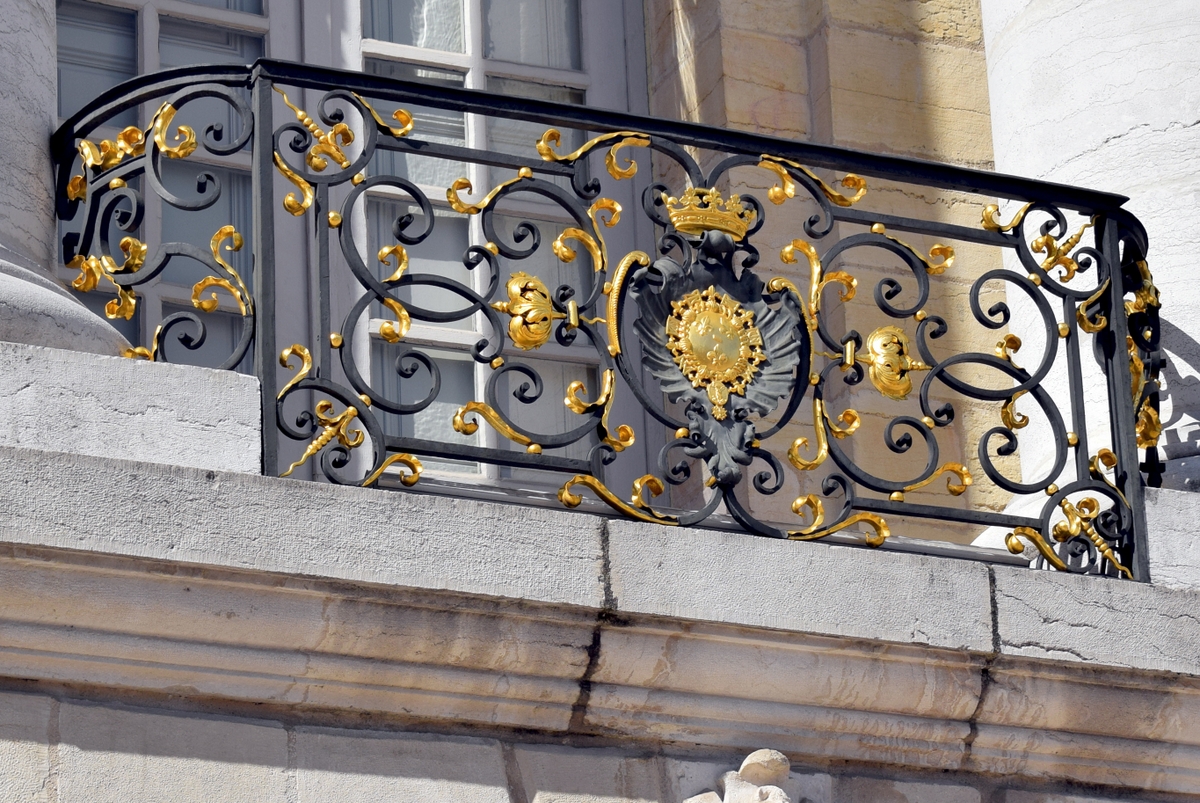


Breathtaking views over Dijon!
Climb the Tower of Philip the Good to admire the view over the rooftops of Dijon (some of them with varnished tiles catching the light!).




Dijon: a paradise for food lovers!
Along with Beaune, Dijon is a gastronomic hotspot! There is a paradise for food lovers. From mustard to gingerbread without forgetting crème de cassis, beef bourguignon, snails…

Read my article on the gastronomy of Dijon to ignite your taste buds!
The Castle of Couches
23kms from Meursault
The castle of Couches is one of those sites we absolutely wanted to see. We first heard about it while reading some tourist brochures prior to our trip to Burgundy.

This medieval castle is also called “Castle of Margaret of Burgundy“. Margaret (c.1290-1315) was Queen of France and Navarre as the first wife of Louis X of France.
The visit includes the exploration of the 12th-century keep (which houses some fine tapestries):

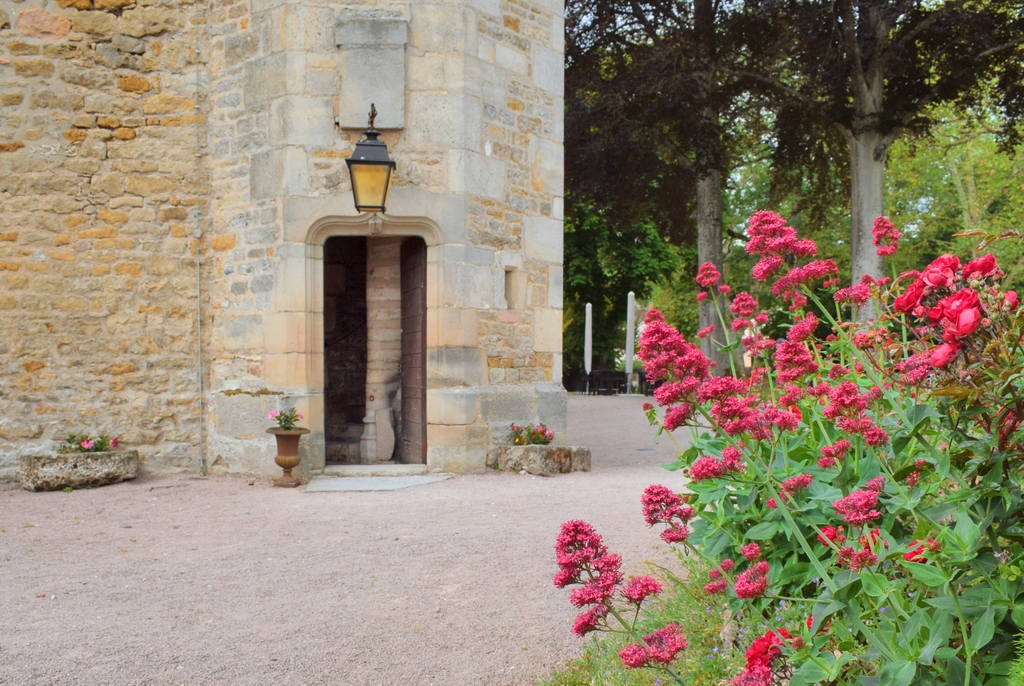

The Flamboyant chapel dates back to 1460:

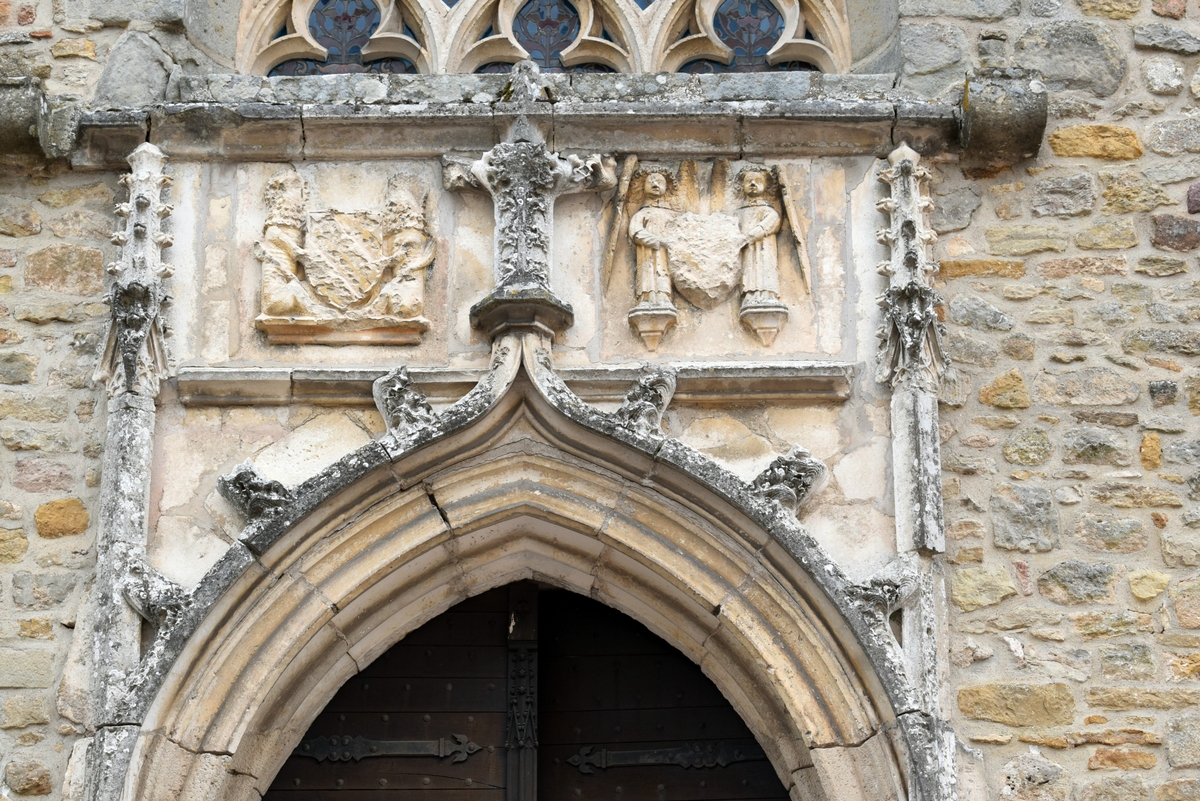
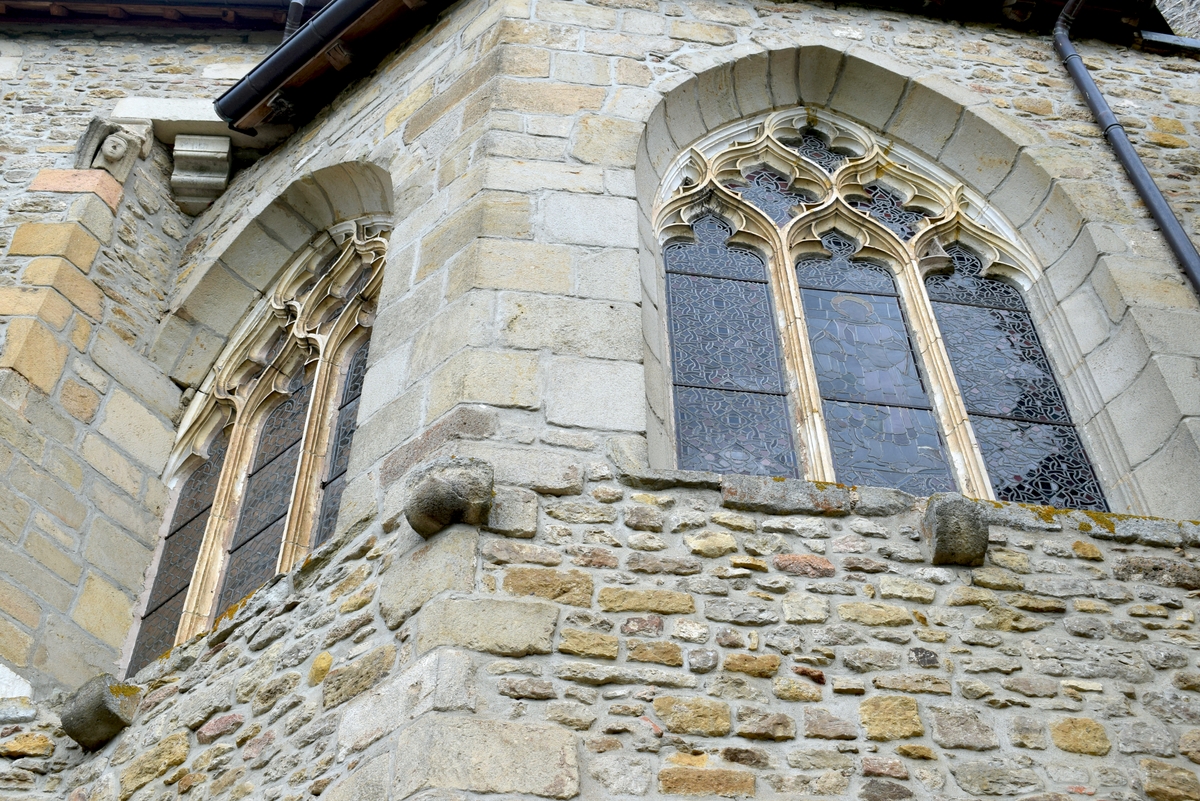
Without forgetting the surprising underground passages (your kids will love them!):
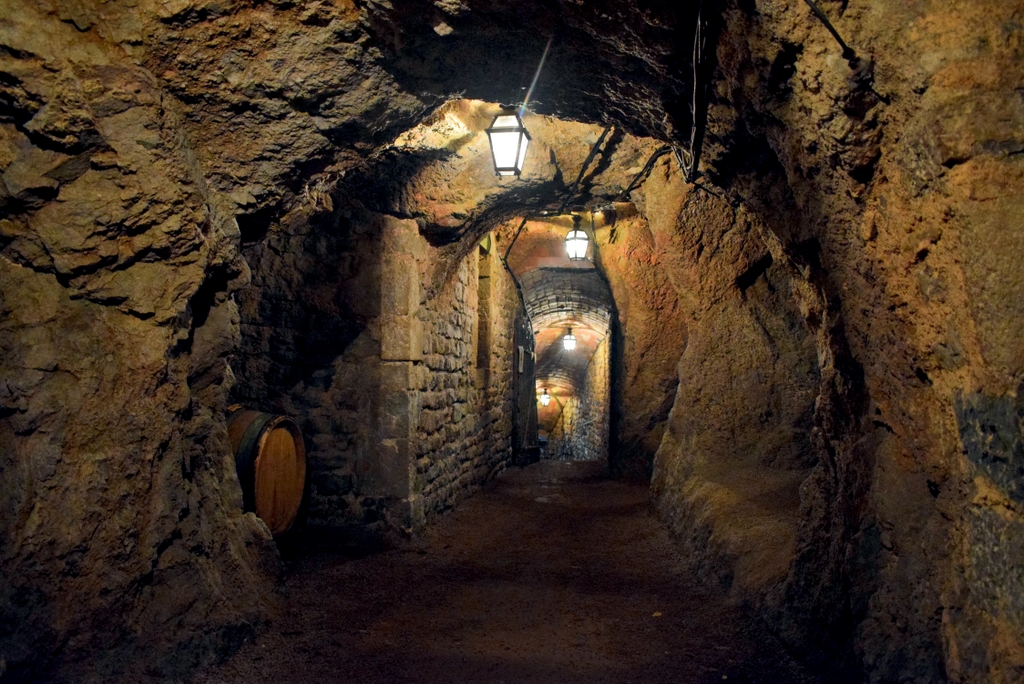
Some buildings are not open to the visit but can be admired from outside. Look out for the varnished tiled corps de logis.

The gardens
And the castle’s domain is graced with beautiful gardens.
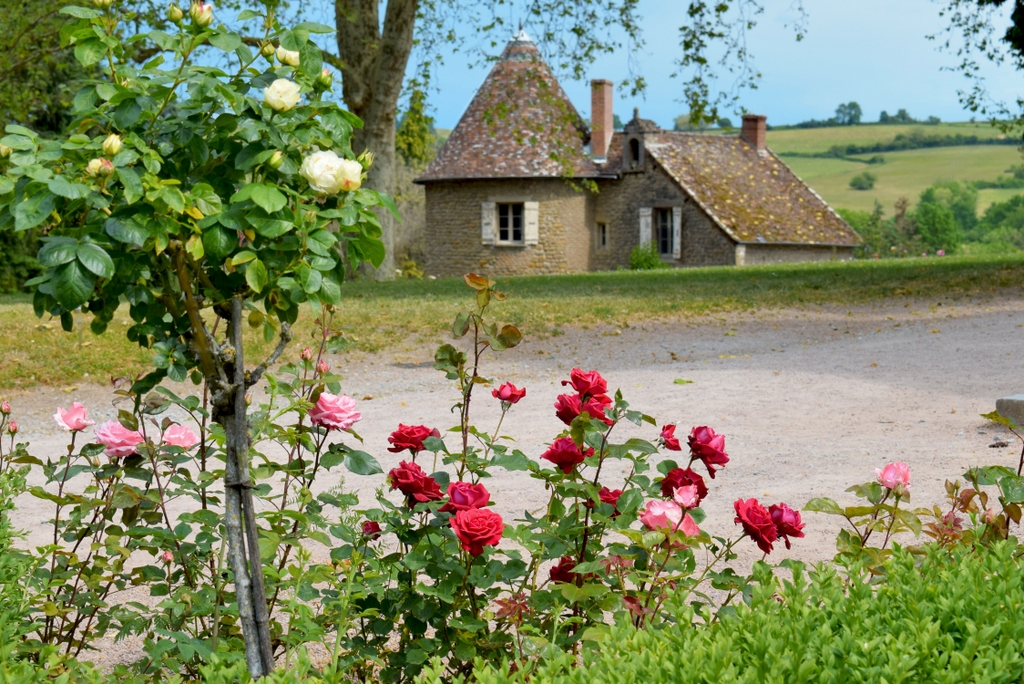





The visit was particularly well organised with audioguides in French and English. Our soon-to-be 6-year-old girl really enjoyed the castle… we found the experience family-friendly and that’s why we highly recommend it.
Lastly, the castle has its own restaurant, “Le Blason de Vair“. It has an elegant but friendly atmosphere inside an outbuilding from the 15th century renovated with great taste. Well-composed dishes are served in silverware and Limoges china. You’ll be spoiled with a refined menu made from local and fresh produce, including wine from the castle’s vineyards.

Find out more about the Couches castle.
The Canal du Centre
On our way to the castle of Couches, we drove along with the Canal du Centre. The canal offers some picturesque views, especially in the village of Saint-Gilles.

The canal appears at its best when textured in the light and shade of a sunny day.
The surroundings of Nolay and La Rochepot
Between the vineyards and the cliffs, the countryside around Nolay is very picturesque. It is home to tranquil villages where time seems to have stood still.
The historic market town of Nolay
14kms from Meursault
On the road to Autumn, Nolay is a market town typical of the Hautes-Côtes de Beaune. It boasts some historic buildings such as:
- The grain-market hall from 1388 with its stone roof. Check out the carpenter beams that support the heavy roof made of flat, sliced stones.

- The historic church of Saint-Martin (rebuilt in the 17th century) with its jacquemart (bell striker). The stone spire is 38 metre-tall. Inside is a Gothic chapel built in the 16th century.

- Stone and half-timbered houses dating from as early as the 16th century.

The village and castle of La Rochepot
9kms from Meursault
The view of the castle of La Rochepot from the D33 road is one of the most beautiful views I’ve ever seen in Burgundy.

The fairy-tale castle of La Rochepot with its distinctive pattern-tiled roof, round towers and pinnacles rises from the woods above the little village.

Although the castle is closed to visitors, it is still possible to marvel at its great medieval style and its fine colourful glazed roof.
The castle of La Rochepot dates back to 1180 and was then called La Roche Nolay castle. It owes its name to Regnier Pot, a knight and Chamberlain to the Duke of Burgundy, who bought it in 1403.
It was a ruin when the Carnot family bought the estate in the late 19th century. They commissioned architect Charles Suisse to rebuild the castle in neo-Gothic-Burgundian style. The glazed-tiled roof also dates from that time of restoration.

A walk in the village…
The enchanting village of La Rochepot which lies at the foot of the castle is one of the most beautiful villages found in Burgundy. Its Romanesque church dates from the 12th century.

We really enjoyed strolling in the tight winding streets of the flower-decked village where the old houses are built on top of each other. The intimate feel of La Rochepot reveals secret corners amateur photographers like me love to shoot!
More photos!

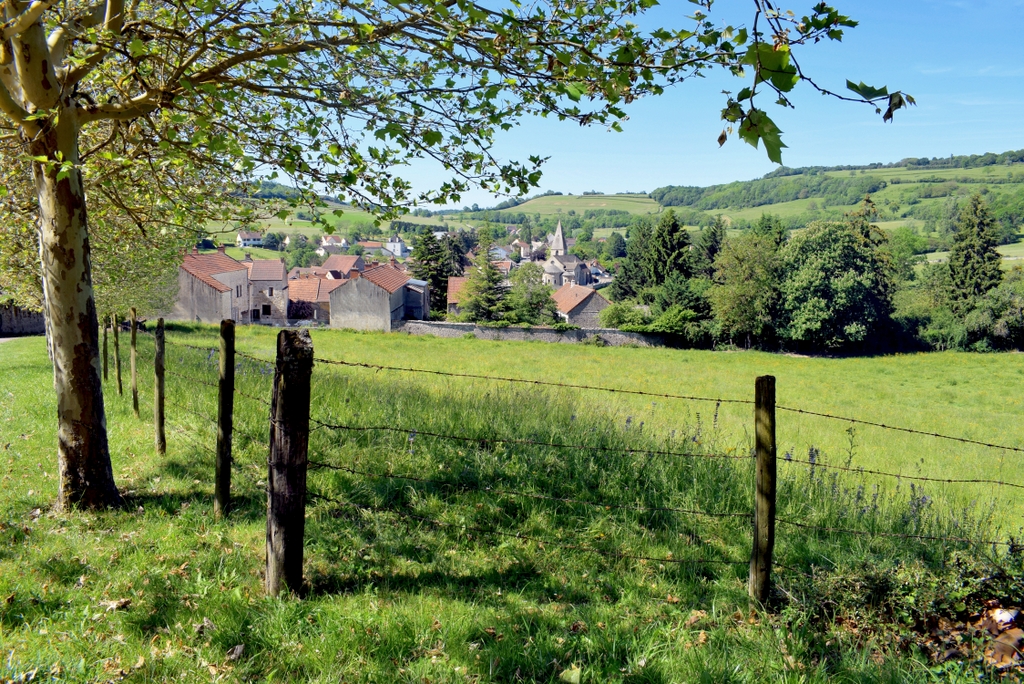




Cirque du Bout du Monde
16kms from Meursault
If I told you we went to the ends of the earth, would you believe me?
Well yes, we did!

The Cirque du Bout du Monde (literally the Cirque of the Ends of the Earth) is in fact a steep head valley and cirque, located in the commune of Vauchignon, not far from the vineyards of Beaune.
This surprising site, overlooked by rocky cliffs, is very popular amongst the locals who enjoy having a family stroll or picnic.

When you reach the end of the valley you’ll find a 40-metre waterfall (which was quite dried out on the day of our visit) falling down from a gap in the limestone cliffs.

More places to see around Meursault in Burgundy
A week wasn’t enough time for us to explore the whole region of Meursault in Burgundy.
There are many other places we’d have wanted to discover… this gives us an opportunity to come back!
Here’s a list of more sightseeing ideas you might be interested in:
- the abbey of Cîteaux, the founding house of the Cistercian order.
- the castle of Savigny-lès-Beaune and its fine collection of racing cars, motorbikes, aeroplanes and vineyard tractors!
- the old centre of Chalon-sur-Saône
- the historic town of Autun
- the industrial town of Le Creusot
- the castle of Sully
Find out more about Meursault in Burgundy
- Link to the luxury holiday home in Meursault we stayed in
- Our article about Burgundy
- Our article about the Gastronomy of Dijon
- The website of the tourist office of Beaune and surroundings (including Meursault)
- The page on Meursault in Burgundy in the tourism website Designed by Bourgogne
- The page about Meursault on Wikipedia
Pin it for later!
Liked what you read about Meursault in Burgundy? Pin it on Pinterest:

A big MERCI to French Holiday Cottages for this unforgettable week in Meursault! This base was incredible and allowed us to tour the surroundings easily.
We would like to thank the following organisations and sites for welcoming us during our exploration of Burgundy:
- Bourgogne Tourisme
- Visitor Information Centre in Meursault (Office de Tourisme)
- Hospices de Beaune
- Tourist Office of Dijon (Destination Dijon)
- Castle of Couches
- Château of Santenay




